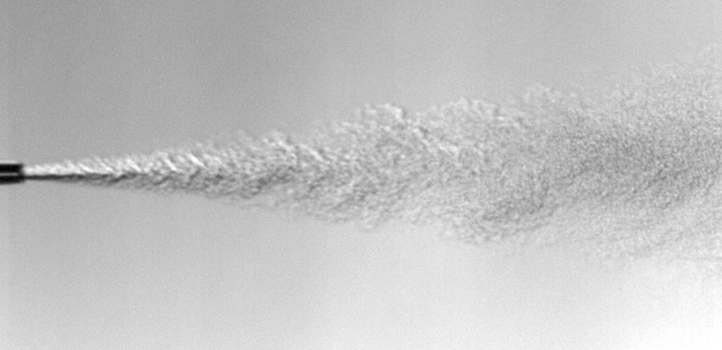Aug 31 2020
A special kind of helium that is capable of flowing without being impacted by friction has now allowed a team of researchers from King Abdullah University of Science and Technology (KAUST) to gain a deeper insight into the conversion of quickly moving liquids into small droplets.
 The team’s high-speed camera images show how small surface perturbations and various forces cause a liquid tube to break apart into droplets. Image Credit: © 2020 KAUST.
The team’s high-speed camera images show how small surface perturbations and various forces cause a liquid tube to break apart into droplets. Image Credit: © 2020 KAUST.
Everyday occurrences, like turning on the kitchen faucet or taking a shower, involve an interesting physical phenomenon called jet breakup. A liquid discharged from a nozzle forms a cylinder when it meets something it cannot instantly mix into—a gas, for instance.
At the same time, numerous forces and slight surface perturbations cause the liquid tube to split into droplets. The whole cylinder atomizes into a fine spray, assumes a wavy or corkscrew-like structure, or pinches off into droplets one at a time at the tip.
Ever since the late 1800s, scientists have attempted to figure out and estimate the behavior of the breakups of liquid jets with the help of classical theories of surface tension, aerodynamics, and viscosity.
But several previous studies present contradictory proof about where to draw the line between different modes of breakup—an issue that could affect manufacturers searching for ways to improve spray technologies.
Engineers are interested in knowing the size and direction of the droplets formed and how far from the nozzle the jet stays intact. There’s so much variety in the ways liquid jets break up.
Nathan Speirs, Researcher, KAUST
Speirs works in Sigurdur Thoroddsen’s laboratory at KAUST.
To upgrade this domain for the 21st century, Thoroddsen’s group teamed up with scientists from the University of California, Irvine, to construct a device that can reach temperatures close to absolute zero with windows for visualizing with high-speed cameras. Liquid helium, at such chilly depths, can assume an array of different behaviors, such as a frictionless superfluid.
It is difficult to work with the experimental setup because “when liquid helium becomes superfluid, the absence of viscosity allows it to escape from the tiniest of imperfections, which we call superleaks,” stated Kenneth Langley, another member from Thoroddsen’s team.
We have to be very careful when closing the cell, and once it’s shut, there’s no way to adjust what’s inside.
Kenneth Langley, Researcher, KAUST
Created using the latest low-temperature device, the comprehensive images allowed the KAUST research team to accurately measure the breakup regimes of liquid jets and detect physical factors that were overlooked by earlier studies.
Our results show that the gas and liquid flows are equally important in the interface region, an idea neglected by most other studies.
Nathan Speirs, Researcher, KAUST
“The irregular shapes of the droplets formed are quite interesting as well, and we hope to analyze them in more detail,” concluded Langley.
Journal Reference:
Speirs, N. B., et al. (2020) Jet breakup in superfluid and normal liquid 4He. Physical Review Fluids. doi.org/10.1103/PhysRevFluids.5.044001.
Slippery superfluids push jets to breaking point
KAUST researchers are studying superfluids to better understand and predict the behavior of jet breakups. Video Credit: © 2020 KAUST.